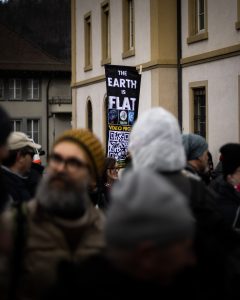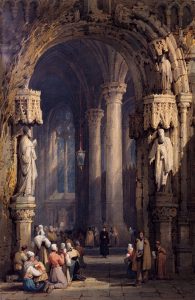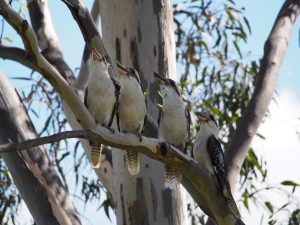July 20, 2025, marks the centennial of Frantz Fanon’s birth. In honoring his valuable contributions to liberatory struggles, I am drawn to his pursuits of playwriting, literature, and poetry in his entanglements with diverse cultures (Martinican, French, Algerian, Corsican, Tunisian, Italian, and Ghanian, among others). The poetry of Aimé Césaire and Léopold Sédar Senghor, and the plays and novels of Albert Camus and Jean-Paul Sartre, influenced Fanon’s early writings. This essay explores Fanon’s critique of the Négritude movement’s “I feel, therefore I am” within the larger context of art’s necessity for not only elaborating normative values, but also motivating the political imaginary. In decolonizing the world—and remaking it—art becomes what Ernst Bloch terms “Pandora with Hope” (277). Karl Marx viewed art as a subversive bastion of the people’s hope. True art, the people’s art, cannot be commodified.
Fanon and Art
“Words, words, words,” Shakespeare’s Hamlet laments in reply to Polonius’s question, “What do you read my Lord?” Hamlet means that the words he reads have no meaning. Looking through the wrong end of the telescope to when I first read Black Skin, White Masks (original French 1952) and The Wretched of the Earth (original French 1961), as a sophomore at Howard University in 1963, I might be tempted to believe the words I read and understood sixty years ago are now merely historical relics. But as memories fade, one must periodically (re)member—put pieces back together—by rereading the works that inspired.
This “Sankofic” reading of Fanon, where the Sankofa bird reaches back to the past to bring forward that which is useful, is the purpose of this essay. Fanon was as much a “man of words,” a polymath, as he was a man of action: artist, soldier, scientist (apparently proud of his knowledge of quantum mechanics), physician, journalist, social theorist, revolutionary, and philosopher. My intent, rather than writing “an infinite deal of nothing,” is to (re)mind the reader to reread Fanon. Richard Pithouse writes, “Frantz Fanon’s books are infused with the incandescent spirit of a remarkable man. They also diagnose alienation with penetrating accuracy, poetic rhythm, and develop a deeply sophisticated and profoundly radical social analysis” (173).
To (re)read Fanon as a revolutionary literary intellectual is to discover him anew. Rereading him is also to recapitulate the struggle for human freedom with an eye toward fulfilling Fanon’s vision. Novelist John Edgar Wideman writes of his determination to emulate Fanon:
[A] determination to be like you, that is, to become a writer committed to telling the truth about color and oppression, a writer who exposes the lies of race and reveals how the concept of race is used as a weapon to destroy people. I wanted to be somebody, an unflinchingly honest, scary somebody like Frantz Fanon whose words and deeds just might ignite a revolution, just might help cleanse the world of the plague of racism. Over the years I gradually resigned myself to the fact that I couldn’t measure up to your example…. (4)
Like Wideman, in reviewing our own struggles with racism and neocolonialism today, we mostly fail to accomplish what Fanon achieved. Yet, if Fanon’s normative vision for a humanism without the alienations of racial domination remains a “not yet,” reading and rereading him, teaching him to our students, and reanimating our agential commitments, reinscribes us “within the circle” of the “beautiful struggle.” Word. Act.
I had originally intended to title this reflection “Black Madness” but found that title had already been taken by Therí Alyce Pickens’s Black Madness::Mad Blackness (2019). Pickens’s work helps recontextualize Fanon in contemporary Afro-futurism and the ongoing liberatory art of Black writers. Disentangling madness as pathology from madness as useful anger, Pickens writes:
Within the long history of Black literature, madness surfaces not solely as pathology or part of a holy fool tradition, but also as a viable alternative to engagements with white racism even if it does not result in increased agency. Madness becomes the place to engage because racism adheres to a particular kind of rationality, predicated on the long history of the Enlightenment and its material effects. (14)
Thus, I suggest, part of the cure for the “mental illnesses” of the bodies, minds, and societies in which Black peoples, still scattered in conditions of racisms and neocolonialisms, is Fanon’s disalienation of the human. In Black Skin, White Masks—whose original title was Essay on the Disalienation of the Black—Fanon states, “My theme being the disalienation of the black man, I want to make him feel that wherever there is a lack of understanding between him and his fellows in the presence of the white man there is a lack of judgment” (38). Fanon’s artful early writing is a healing meditation on alienation.
The Drowning Eye

In Fanon’s play The Drowning Eye, two brothers struggle with meaning, one brother a symbol of Apollo, the other a symbol of Dionysus. The play is available in Alienation and Freedom (2018), from which I take the text of Fanon’s plays and the commentary from its editors, Robert Young and Jean Khalfa, in what follows. This play clearly reveals Fanon’s musings on Nietzsche. The brother of “light” wants the brother of “darkness” to make an “existential choice” for life and freedom. Young’s exegesis of Fanon’s play also points to Søren Kierkegaard’s Either/Or (original 1843), the existential moment of the “aesthetic man” or “the Knight of Infinite Faith,” a life of pleasure or a life of belief. Young characterizes Fanon’s antagonist in The Drowning Eye as follows:
His indifference, incommunicativeness, ennui, lack of emotion and conviction of the absurdity of life recalls something of Meurseult in Albert Camus’ L’Étranger (The Outsider) (1942). Structurally, of course, Fanon’s alienation was the reverse of Meurseult’s: the play expresses and attempts to transcend the oppression and alienation of the colonized. (25)
Young’s analysis of Fanon’s The Drowning Eye situates Fanon’s literary struggles as an outsider (a stranger) at home in Martinique, in medical school in Lyon, France, and as a psychiatrist in Algeria and Tunisia. Literary existentialist literature is a dialectic between non-belonging in a nostalgic search for home and the alienist disillusionments of being lost in an uncaring universe. Fanon locates the “stranger” in himself as a soldier fighting in a war where he himself is the enemy of French culture, in a culture where his blackness is alienating, and in mental clinics in Algeria where he is a psychiatrist who does not speak the language of his patients.
The Drowning Eye is the “either/or” of seeing and blindness, of seeing and being seen, belonging and not belonging to life. As Young observes, “In wishing to be blind, to be worthy of the spectacle in order to see the elemental ontological reality behind it, François follows the logic of Nietzsche’s Apollonian and Dionysian dialectic according to which the Dionysian artist pushes the human world of appearance (Schein) to its limits in order to perceive the essence of what lies behind or beyond” (45). The transcendences Fanon seeks in The Drowning Eye are antecedent to demasking the deceptions of black skin and white masks in the Antilles and making sense of the uncanny insanity of whites imposing upon themselves their intrinsic superiority or godlike being outside the mental clinics. “To never see the void again,” to never experience “nothingness,” is the freedom—in merging with the physical world beyond words and appearances—Fanon’s existential anti-heroic characters can see and yet are blind, too.
Where The Drowning Eye might mistakenly be construed as part of Fanon’s juvenilia—especially because it was written in 1949 when he was twenty-four—a careful reading reveals a deeply-structured drama with complex themes. Ostensibly a love triangle involving the loss of self and betrayal, The Drowning Eye is a setting sun’s affirmation of love as an act of resistance. The players are François the nihilist (night), Ginette his lover, and François’s elder brother Lucien (light). Other minor characters are a blind black cat and a blind servant who is apparently offering comments from off-stage. The struggle between the blindness of death and the sightedness of daylight, with love mediating Ginette’s affections between the brothers, is François’s blindness of beautiful windblown stars without human interaction, and Lucien’s creation of meaning in the Sun’s dawning light. Lucien says: “When words scratch each other’s eyes out, the only remaining resource is action” (92).
Later, Lucien reveals to Ginette, “One day he confided to me he would like to be blind” (93). As Lucien’s seduction of Ginette proceeds through the night, she repeatedly resists, proclaiming, “He’s right,” as she’s seen the beautiful austerity of François’s darkly absurd view of the exceptionalism of human existence. Ginette acknowledges François’s view: “It’s over Lucien, humans have lost” (104). But having been seduced by Lucien’s optimism, Ginette returns to François, declaring, “I hoist my frailty up to the audacious limit of your refusal” (105). This surprising and fickle return to François is accompanied by her remark, “but this abyss sustained within myself. I had to fill it.” François responds: “I want to lead you to the ABSOLUTE gates where life is seized” (112).
Young’s analysis explicates the significance of “the absolute” in Fanon’s plays:
Fanon’s play moves between two interrelated conceptions of the Absolute…whereby it is momentarily experienced as at once both the truest experience of the self and of the non-self…Where I (the eye) realize myself by drowning myself. (52)
This dialectical tension between being or nothingness, self or non-self, nihilism or affirmation, either/or, Apollonian or Dionysian, life or death, resolved in the denial of seeing in the affirmation of blindness, is a mask for inaction. Not to decide is a decision. Seeing “blackness” ontologically as self, rather than non-self, requires the mediation of love for an indifferent cosmos. Evidence that Fanon’s The Drowning Eye remains relevant is its performance in 2022 at the Market Theatre in Johannesburg, South Africa.
Fanon’s other play, Parallel Hands, is a Greek “Oedipal tragedy,” a murderous event that “ends a kingdom” and results in a chaotic triumph for darkness. Fanon wrote this play while a medical student in Lyon. Camille Robcis writes: “Surrealism and psychiatry, in other words, shared similar goals of rehumanizing madness and fighting against the ‘absurd order’ of the world” (35). Parallel Hands, as Greek tragedy, returns to “Words, words, words!” in groping to transform words into ACTS.
Echoing Sophocles’ Oedipus Rex, the hero of Parallel Hands, Épithalos, murders his father, Polyxos the King, on his own wedding day. This regicide and parricide leave the heroine Audaline in despair, leading to her suicide. Dràhna, the queen mother, repeatedly implores, “What have you done?” Invoking the ACT, against the stagnation of two thousand years of inertia in the symbolic city of Lèbos, Épithalos responds: “An ACT! I want to spatter this pregnant sky with a vertiginous act! / Parallel hands make the starry world ring out with a new act.”
According to Young, Fanon’s aim is to transform the oedipal fight to the death of the “master” in master/slave scripts. Young also writes that the play can be interpreted “as an attempt to break through the social illusion of ideology in a Marxian sense…people…accepting uncritically the terms of a lifeless world into which they have been born” (65).
Parallel Hands
In Parallel Hands, Fanon appears to embrace the view that freedom, as the only absolute, is only achievable in the act. Condemned to freedom, we are also condemned to act:
Épithalos: EVENT! Stamping about the other side of life, at the doors of the Gaze I raise myself absolute!
…[V]ainglorious hands that refuse to touch each other.
…To see the VOID no more.
Ménasha: Épithalos, the night is done
my eyes clutch divine things
Lébos becomes organized once again Blessed is darkness.
Épithalos—(like flesh torn by a hail of bullets) I SEE.
Curtain. (130–131, 164)
Is Épithalos’ “I SEE” an affirmative act of freedom or an admission of nihilistic negation in “seeing” the futile void? The feminine character Ménasha’s affirmation that “Blessed is the darkness” negates the negative by rendering it equivalent to the light. If freedom is the only absolute, alienation evinced in the phalanx of war, patriarchy, colonialism, race, and madness is darkness. Young, commenting on the play, quotes Marx on art, “most notably the quotation from The Eighteenth Brumaire on social revolution drawing its poetry from the future” (65). Fanon’s poetic plays are his poetry from the future.
Fanon’s words in this drama show his preoccupations with aesthetic formalisms: in poetic language (he read the poetry of Aimé Césaire with great interest), in the theater (he frequented plays by Sartre and Camus), and in philosophy (he attended lectures by Merleau-Ponty while a medical, philosophy, and sociology student). Jean Khalfa writes, “It is well known in particular that Fanon read a lot of poetry and theatre” (719). A cursory examination of his personal library compiled at the time of his death reveals volumes by Georges Bataille, Jorge Luis Borges, Bertolt Brecht, Albert Camus, René Char, and Aeschylus, among many other important literary figures.
It is our refusal to see (The Drowning Eye) and to act (Parallel Hands) that forces us to be unfree (institutionalized and colonized). Fanon’s counter-reason, his metacritique, in saying no to no (by acting) and seeing ontological reality (“seeing the void no more”) in freedom initiates “the great refusal.” Fanon’s “no” can be traced through Herbert Marcuse to The Invisible Committee. Saying “words, words, words” and acting in resistance require a new “no” that is not empire’s “no.” Denial is an art form.
In Black Madness::Mad Blackness, Pickens elaborates how Blacks being banished from “Time” (history) in a Space-time continuum, leaves only the static “space” of objects. So, the Black body is ontologically objectified in a world where only whites move through time dynamically and Blacks are rendered passive objects to be acted upon in space. Thus, regaining history (thereby the temporality of “becoming”) becomes a major impetus for Black legitimacy and authenticity. Attempting to mediate white ontological “being-in-time” by a reciprocal Black “being-in-time,” in order to produce a “being-in-time” for a new human culture devoid of race, requires the Aufhebung, cancelling and retaining meaning in an antithetical historicity capable of sublating the dominant thesis. Fanon’s poetic writing creates a Black meta-temporality, a new time. His sublime becomes not the dialectical tensions between “I think, therefore I am” and “I feel, therefore I am,” but “I act, therefore I am.”
Lewis R. Gordon, commenting on Fanon’s actional philosophy: “Fanon’s philosophy can be summarized by a single conviction: Maturity is fundamental to the human condition, but one cannot achieve maturity without being actional, which, for Fanon, is tantamount to freedom” (89). Again, scanning holdings in his library, Fanon was avid in his philosophical pursuits. A partial list of his books includes Aristotle, Bergson, Camus, Comte, Descartes, Hegel, Husserl, Kant, Kierkegaard, Levinas, Lukacs, Nietzsche, Pascal, Plato, Russell, Sartre, and Spinoza.
To demonstrate Fanon’s profound respect for philosophy—and emphasize the fact that he was himself a philosopher—his dedication to Professor J. de Rougemont in his Doctoral thesis states, “In him I have discovered a major philosophical proficiency, philosophy being the risk that the mind takes to assume its dignity” (my italics, 204). So, from Existentialist philosophy, canonical western philosophy, literature, and poetry, Fanon sought to alleviate the suffering of colonialized peoples in its somatic (biogenic), mental (psychogenic), and social (sociogenic) forms. Like the ancient Greek philosophers who viewed themselves as “healers” of the soul, Fanon’s diagnostic, prognostic, therapeutic, and recuperative reintegration—as a “medical” doctor of the body, “psychiatric” doctor of the mind, and “philosophical” doctor of the society—in his brief life, Fanon would be like Socrates, a “midwife” to the violent birth of a new world.
Conclusion
In conclusion, Fanon’s early writings—as liberatory art—developed his understanding of the human aesthetic and influenced his later better-known works. Existentialism as a philosophy and a literary movement informed his clinical psychotherapeutics, political thought, and revolutionary activism. When Fanon writes in Black Skin White Masks, “I came into this world anxious to uncover the meaning of things, my soul desirous to be at the origin of the world, and here I am an object among other objects” (89), he is constructing a world, the modern world. “I should constantly remind myself that the real leap consists in introducing invention into existence. In the world through which I travel, I am endlessly creating myself” (229).
In Fanon’s final prayer—“O my body, make of me always a man who questions!”—he opens his “Drowning Eye” to see his (and our) freedom. As Stuart Hall observes in Isaac Julien’s film Frantz Fanon: Black Skin, White Mask (1995), “Racism appears in the field of vision.” Racism is an empirical phenomenon. We can see it, yet what we perceive can be otherwise. After reading Fanon, Camus, and Sartre when I was still a teen, I became a Black Existentialist. Amid my own racial alienations, enthralled by the power of his poetic “voice,” I wanted like Fanon, to create my own meanings.
Gordon writes, “The brilliance of Fanon’s works is their evocative force….I continue to study him because he is a writer who has created a world” (178). A world where, I might add, “To see the VOID no more” requires acts of freedom.
The post The Aesthetics of Black Madness first appeared on Blog of the APA.
Read the full article which is published on APA Online (external link)




